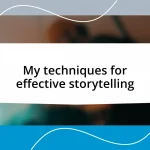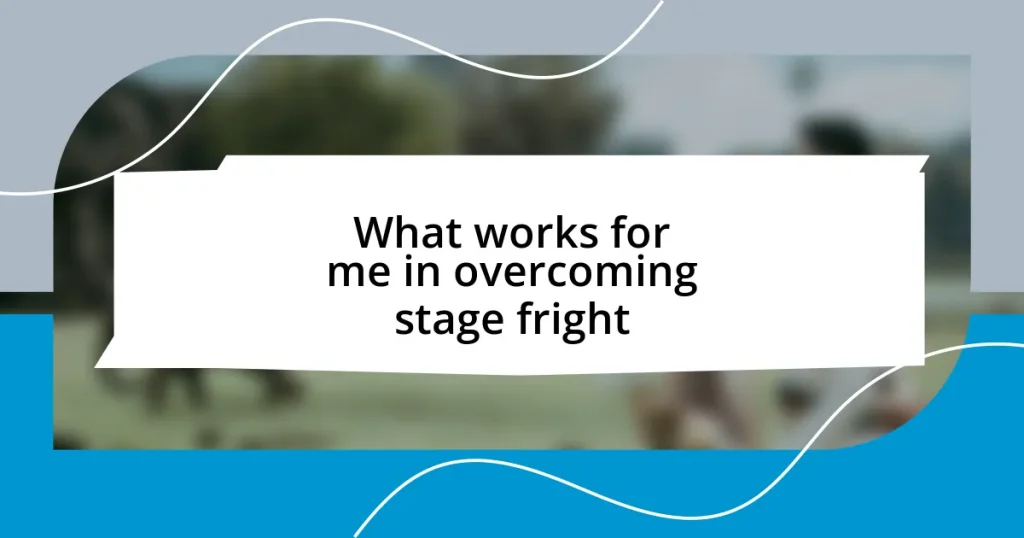Key takeaways:
- Understanding audience needs enhances engagement; active listening and seeking their expectations fosters connection.
- Craft relatable messages by sharing personal anecdotes, using humor, and acknowledging shared feelings to create a sense of community.
- Storytelling techniques, like the hero’s journey framework and suspense, make presentations immersive and relatable, inviting audience participation.
- Encouraging audience interaction through tools like polls and personal stories transforms a passive audience into an active, engaged community.

Understanding audience needs
Understanding audience needs requires more than just surface-level analysis. I remember once presenting at a workshop where I had meticulously crafted my slides, but I quickly realized that the audience craved interaction over information. This moment taught me that true connection comes from being attuned to what people genuinely seek, whether it’s knowledge, inspiration, or simply a space to share their thoughts.
Have you ever felt that disconnect during a presentation? I certainly have. There was a time when I focused solely on delivering content, neglecting the emotional landscape of my audience. Now, when I create content, I ask myself what emotions my audience might be experiencing. This shift has made my presentations more relatable and engaging—people want to feel heard and understood.
It’s fascinating how understanding audience needs can shape the entire experience. In my experience, I often conduct informal polls or conversations before diving into a presentation. This approach not only gives me insight into their expectations but also fosters a sense of belonging. When audiences see that their unique needs and preferences matter, they are far more likely to engage and connect.

Crafting relatable messages
Crafting relatable messages is about weaving personal experiences into the fabric of your communication. I recall a time when I shared a story from my own life during a talk—it was a simple moment, yet it resonated deeply with the audience. This unexpected connection allowed me to see their faces light up with understanding and empathy. I think people crave authenticity, and when I share my vulnerabilities, it opens the door for others to connect on a more profound level.
Here are some strategies I use to craft relatable messages:
– Use personal anecdotes: Sharing my own stories makes the message more real and relatable.
– Incorporate humor: A light-hearted joke can ease tension and create a bond with the audience.
– Employ everyday language: Avoiding jargon keeps the conversation accessible and engaging for everyone.
– Acknowledge shared feelings: Pointing out common emotions helps to establish a sense of community within the audience.
– Use visuals and metaphors: They can help illustrate concepts in a way that feels personal and understandable.
Ultimately, when I emphasize shared experiences and emotions, I create a space where my audience feels seen and valued.

Using storytelling techniques
Using storytelling techniques has proven to be one of the most effective ways to connect with an audience. I vividly remember a presentation where I shared a childhood story about overcoming my fear of public speaking. The audience’s reaction was immediate; some laughed, others nodded in understanding. This experience highlighted how storytelling creates a personal bridge, allowing people to relate to experiences that evoke similar feelings and memories.
As I refine my storytelling approach, I often focus on the “hero’s journey” framework. It’s fascinating how a simple structure can amplify the impact of a message. By framing myself as the protagonist who faces challenges, learns lessons, and ultimately triumphs, I invite the audience into a narrative that feels both familiar and inspiring. They are no longer just listeners; they become part of the journey, cheering for the outcome.
One technique that has been incredibly effective for me is the art of suspense. In a recent workshop, I shared a gripping anecdote but paused right before the climax. The anticipation in the room was palpable. This moment taught me the power of timing in storytelling; it could literally keep an audience on the edge of their seats. By carefully crafting my stories, I transform a mere presentation into an immersive experience that fosters closer connections with my audience.
| Technique | Description |
|---|---|
| Personal Anecdotes | Sharing personal stories makes the message relatable and engaging. |
| Hero’s Journey | Structuring a story as a journey creates empathy and connection. |
| Suspense | Building anticipation enhances engagement and keeps the audience invested. |

Leveraging body language effectively
When it comes to connecting with an audience, I’ve learned that body language can be a powerful tool. I vividly remember a time during a training session where I used open gestures and made eye contact with participants. I noticed how their posture mirrored mine—they leaned in, engaged and eager to learn. This experience reinforced my belief that our nonverbal cues can either invite or repel connection.
One effective strategy I employ is mirroring. Have you ever noticed how people often feel more comfortable around someone who reflects their own movements? During a recent workshop, I consciously mirrored the relaxed posture of my audience. It was striking how their initial hesitance transformed into openness, almost like an unspoken agreement was forged. This simple act of mirroring can create a feeling of safety and belonging, which is essential for impactful communication.
I also pay close attention to my facial expressions. I vividly recall a presentation where I shared a serious topic but paired it with a warm smile. The resulting contrast lightened the atmosphere, prompting laughter at appropriate moments. This taught me the art of balancing seriousness with warmth; after all, aren’t we all human, capable of both gravitas and joy? By leveraging body language effectively, I foster an environment where genuine connection flourishes, making each interaction more memorable.

Engaging through visual content
Visual content has a unique ability to captivate audiences and convey messages with clarity that words sometimes can’t achieve. I recall a webinar where I used infographics to illustrate complex data. Instead of overwhelming participants with figures, the visuals turned dense information into digestible bites. I could see the nods of understanding, as if the images resonated with their own experiences. Isn’t it amazing how a well-designed visual can simplify complexity and invite curiosity?
One approach I’ve found incredibly engaging is using relatable imagery that mirrors my audience’s experiences. During a campaign for a local charity, I incorporated photographs of community members participating in our events. This not only fostered a sense of belonging but also made the message feel personal. People responded not just to the cause but to the familiar faces; they saw themselves represented in our mission. Can visuals create empathy that words alone struggle to evoke? From my experience, they undoubtedly can.
Animation can also work wonders! I once utilized a short animated video to explain a rather technical concept during a lecture. The colorful characters and dynamic movements kept the audience’s attention riveted, sparking conversations afterward that I didn’t anticipate. It dawned on me then just how powerful motion can be in storytelling. When we embrace visual content, we invite audiences to participate in a shared visual journey. Isn’t that what great communication is all about—a shared experience that resonates long after the moment has passed?

Encouraging audience interaction
Encouraging audience interaction goes beyond mere words; it’s about creating a space where people feel comfortable engaging. I once attended a conference where the speaker opened the floor for questions right after laying out the main points. It felt refreshing! Participants eagerly chimed in, sharing perspectives that sparked dynamic discussions. This taught me that when you invite your audience in, they often surprise you with their insights, don’t you think?
In my experience, using interactive tools can significantly enhance participation. During a recent workshop, I used live polls to gather feedback in real time. The instant results were displayed on screen, creating an electric atmosphere as attendees expressed their views. Honestly, nothing beats witnessing that sense of connection when people see their opinions reflected back. It’s this engagement that transforms a passive audience into an active community.
I also find that storytelling is a powerful catalyst for audience interaction. I remember sharing a personal story during a presentation, and afterward, attendees flocked to share their own experiences related to the theme. Opening up about a vulnerability not only humanizes the speaker but also paves the way for others to share their journeys. Isn’t it fascinating how a simple story can bridge gaps and foster deeper connections among us all? This creates a vibrant dialogue, making the entire experience more meaningful for everyone involved.

Evaluating audience feedback
Evaluating audience feedback is a critical step in refining how we connect with our listeners. I remember a time after a presentation when I reached out to attendees for their thoughts. Their candid responses offered insights I never could have anticipated; some found certain parts enlightening, while others felt I lost them in jargon. It hit me hard—I realized that genuine feedback is not just valuable but essential for growth.
When assessing feedback, I find it crucial to look for patterns rather than focusing on isolated comments. For instance, after I implemented a post-event survey, I was amazed to see recurring themes about how people valued storytelling over statistics. That revelation was like a light bulb moment for me. It reinforced the idea that we should prioritize relatable content in our communications, leading me to rethink my approach completely.
Sometimes, it’s easy to overlook non-verbal cues as well. I distinctly recall a workshop where I caught several participants leaning in, nodding, or smiling during specific segments. Those silent signals complemented the written feedback, indicating that engagement sometimes goes beyond words. Have you ever paid attention to how the audience feels in the moment? It’s these subtle expressions that can be just as telling as formal feedback forms, helping us gauge the impact we have on others.













